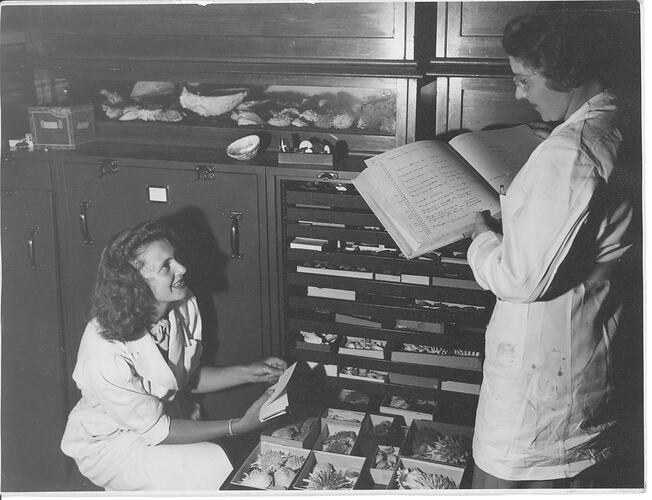Summary
Black and white image of Shirley McColl on the left and Hope Macpherson on the right in front of a series of drawers and cabinets providing storage for the Mollusca Collection. When this image was taken Hope had been working for the museum for approximately 12 years and it was two years after receiving her degree at Melbourne University and being appointed National Museum of Victoria's first female Curator.
Hope along with Isobel Bennett, Susan Ingham and Mary Gillham were the first women to visit the Antarctic in their December 1959 expedition.
Description of Content
Black and white image of Shirley McColl on the left crouched down and looking up at Hope Macpherson on the right holding a handwritten book. Behind them is a series of drawers and cabinets providing storage for the Mollusca Collection. When this image was taken Hope had been working for the museum for approximately 12 years and it was two years after receiving her degree at Melbourne University.
Physical Description
Black and white image.
Significance
The Hope (Macpherson) Black Collection is a significant addition to Museum Victoria's working lives collection, it reveals the journey of a woman from depression era Melbourne and illustrates the power of education. It also reveals the often discriminatory policies in place in Victoria before the equal opportunity developments of the late 20th century. In balance though it also exposes the somewhat free expression possible for empowered women in this period. Hope Macpherson clearly states that in her day to day work she never felt discrimination and believes she was given great opportunity to pursue her career and aspirations. However, on analysis her role was often shaped by her gender and its perceived strengths and weaknesses; she was dissuaded from applying to become a taxidermist as it was 'an unsuitable job for a woman', although part of the first group of female scientists allowed to travel to Macquarie Island they were not permitted to camp on land with the male crew for fear of inciting passions. And finally after a distinguished career she was forced to resign her tenure as Australia's first female Curator when she married late in life, as a consequence of the Marriage bar.
More Information
-
Collection Names
-
Collecting Areas
-
Acquisition Information
Donation from Hope Black (nee Macpherson), Apr 2011
-
Person Depicted
Miss Hope Macpherson - National Museum of Victoria, Melbourne, Greater Melbourne, Victoria, Australia, 1948
-
Person Depicted
Shirley McColl - National Museum of Victoria, Melbourne, Victoria, Australia, 1948
-
Format
Photograph, Black & White
-
Inscriptions
Shirley McColl 2313 and Hope Macpherson (Black) in the Mollusca Collection National Museum of Victoria 1948 [Handwritten in pencil and black ink] Australian Official Photograph, Dept. of Information [Stamped in purple ink].
-
Classification
-
Category
-
Discipline
-
Type of item
-
Image Dimensions - Photograph
208 mm (Length), 158 mm (Width)
-
Keywords

